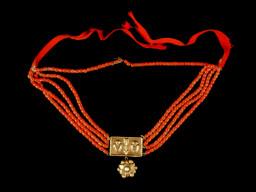A show on the ruby wonders of Sicily's Baroque coral creations has drawn in huge crowds in Turin this summer.
Over 50 miniature masterpieces, carved between the 16th and 17th centuries, pay tribute to the start of Sicily's golden age in the harvesting and working of precious red coral.
A range of items are on display, including plates, vases, jugs, boxes, cabinets, goblets, lamps, monstrances, as well as an array of jewellery.
Although active for centuries, Sicily's coral industry bloomed during the 1500s when a wealth of new colonies were discovered around the island of Tabarca.
Master coral workers in Trapani on the western coast of Sicily, mostly from the Jewish community, started developing sophisticated new art forms.
Traditionally the local coral industry had focused on producing beads for jewellery and rosaries.
However, the sudden availability of more red coral led workers to shape ever more elaborately sculpted pieces, an art form in their own right.
The style varied over the decades, interwoven with developments in jewellery trends and sculpture.
At the end of the 1600s, there was a move from simple sculpted figures towards pieces displaying ever greater detail, such as profusions of tiny leaves, twigs and flowers that were then attached to other objects using metal pins or threads.
Coral can be found in seas around the world but red coral, or corallium rubrum, grows solely in the Mediterranean off the coasts of Sicily, Corsica and north Africa.
Red coral, also known as precious coral, is the only form of coral valued for jewellery and is today increasingly rare.
Coral is actually made from thousands of marine organisms called polyps, which secrete calcium carbonate to form a hard skeleton.
According to Greek mythology, red coral was created after Perseus placed Medusa's head on a riverbank while washing his hands. Blood from her head dripped into the water, and turned the seaweed there red.
Rosso Corallo. Arti preziose della Sicilia Barocca (Red Coral: Precious Artworks from the Sicilian Baroque) is on show in Turin's Palazzo Madama until September 28.








